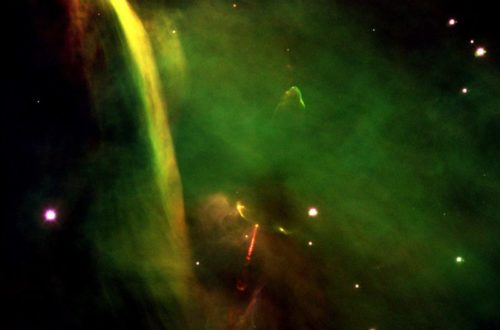Stargazing Calendar for October 2025
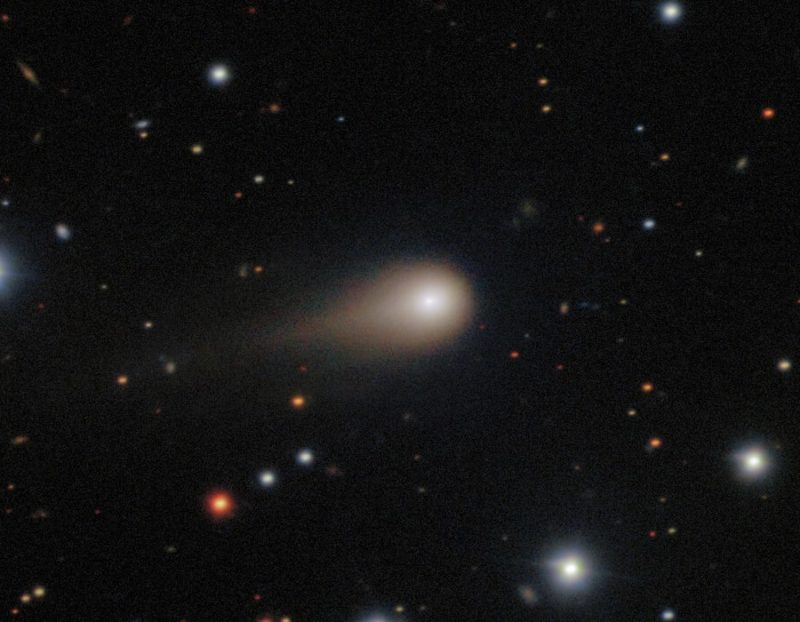
This month, the night sky is filled with rare and captivating sights. From bright meteor showers and close planetary pairings to the arrival of an interstellar comet and oppositions of distant dwarf planets, every evening offers something new. For those passionate about astronomy, stargazing this October 2025 will be a sight to remember.
Would you like to be notified of stargazing events?
List of Meteor Showers in October 2025
- ν-Eridanids: Start on September 1; peak on September 6; end on October 29.
- Daytime Sextantids: Start on September 9; peak on September 27; end on October 9.
- October Camelopardalids: Start on October 5; peak on October 6; end on October 6.
- Draconids: Start on October 6; peak on October 8; end on October 10.
- Southern Taurids: Start on September 10; peak on October 10; end on November 20.
- δ-Aurigids: Start on October 10; peak on October 11; end on October 18.
- ε-Geminids: Start on October 14; peak on October 18; end on October 27.
- Orionids: Start on October 2; peak on October 22; end on November 7.
- Leonis Minorids: Start on October 19; peak on October 24; end on October 27.
- Northern Taurids: Start on October 20; peak on November 12; end on December 10.
We also have a complete list of meteor showers for the entire year of 2025 here.
List of Planetary Conjunctions in October 2025
- Conjunction of the Moon and Saturn in Aquarius on October 6.
- Close approach of the Moon and Pleiades in Taurus on October 10.
- Conjunction of the Moon and Jupiter in Gemini on October 13.
- Conjunction of the Moon and Venus in Virgo on October 19.
- Conjunction of Mercury and Mars in Libra on October 21.
- Conjunction of the Moon and Mars in Libra on October 23.
- Conjunction of the Moon and Mercury in Libra on October 23.
Moon Phases in October 2025
As you know, the Moon has a big impact on the visibility of celestial bodies and astronomical events in the night sky. So to help you with stargazing, here’s a calendar of the phases of Moon for this month of October 2025:
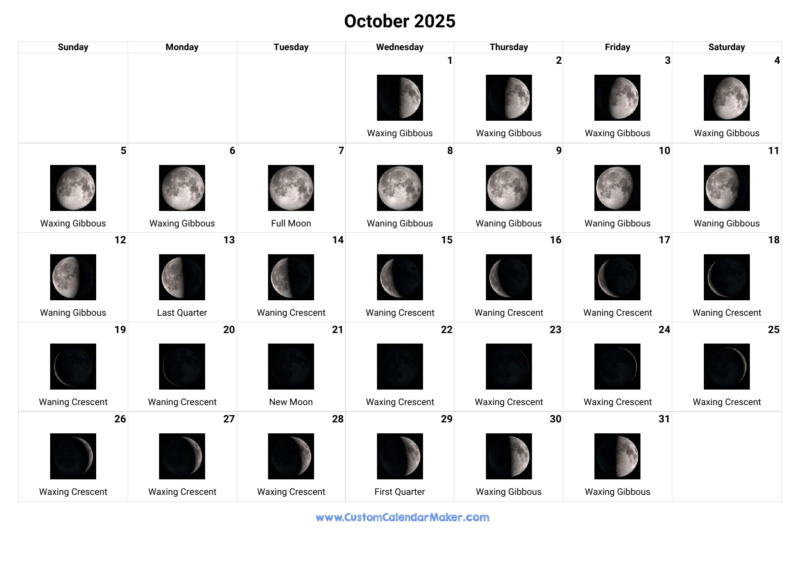
October 2: Dwarf planet Ceres at opposition
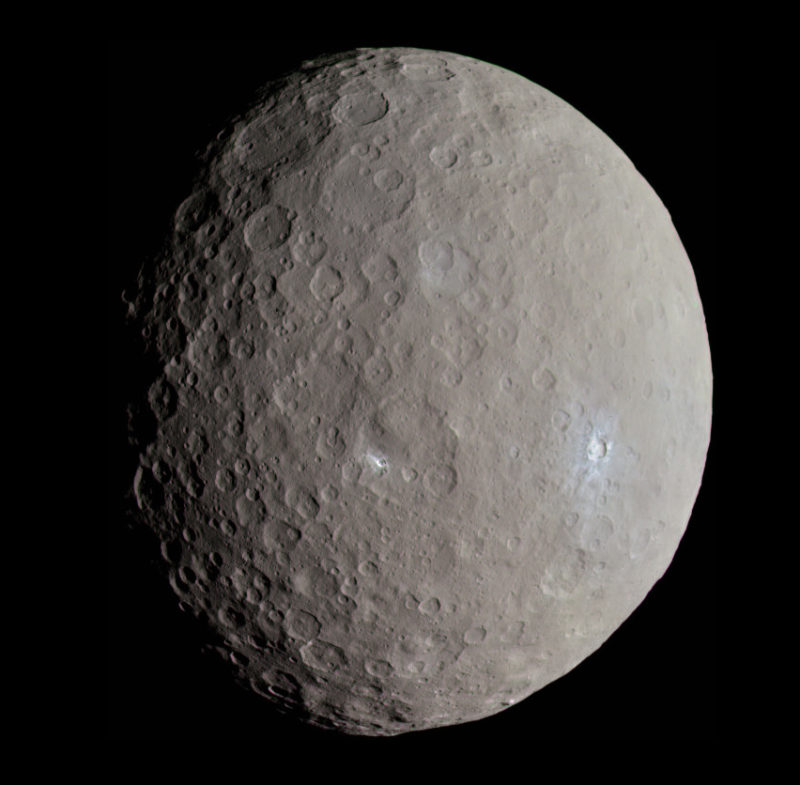
The dwarf planet 1 Ceres will be at opposition at around midnight local time. It will reach the highest point in the sky and opposite to the Sun.
At the same time Ceres will be closest to the Earth (perigee) at a distance of 1.96 AU. At this time it will be the brightest, with an apparent magnitude of 7.6. Look in the constellation of Cetus with binoculars or a telescope. The Moon will be 11 days old waxing gibbous at about 79%, so it will unfortunately be interfering with stargazing during the October 2025 Ceres opposition.
At a mean diameter of 939.4 km Ceres is the largest asteroid and first one discovered in 1801, by Giuseppe Piazzi. Ceres was named after the Roman goddess of agriculture. It is also the nearest dwarf planet and has a surface gravity of just under 3% of Earth’s.
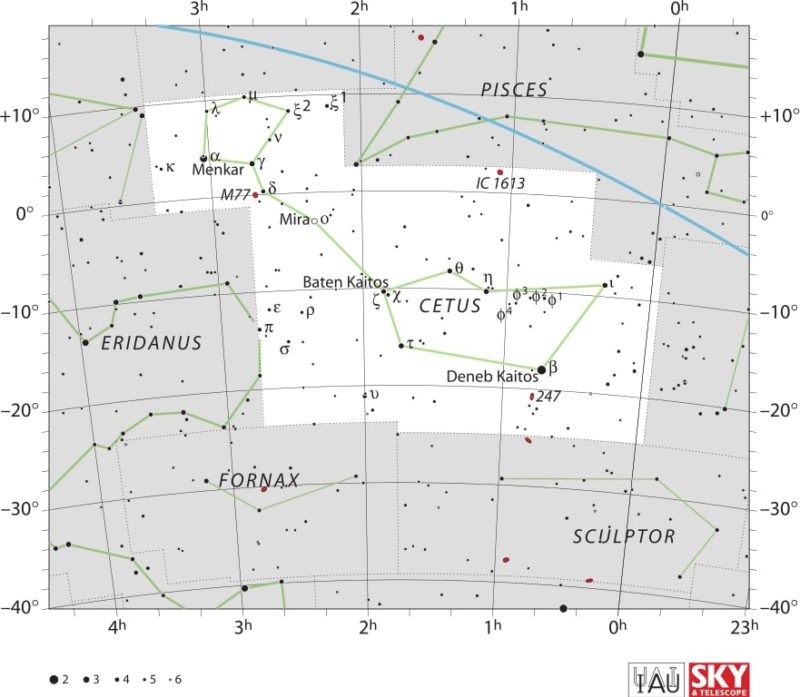
October 2: The Andromeda Galaxy at its highest point in the sky
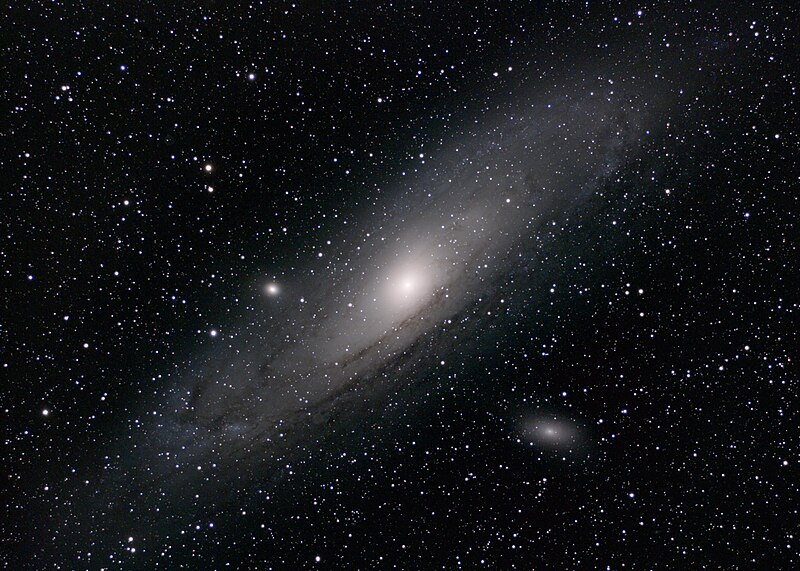
The largest galaxy in the local group, Andromeda (Messier 31, M31, or NGC 224), will reach its highest point in the sky at around midnight local time.
The galaxy will reach an apparent magnitude of 3.4, and the Moon will be 11 days old waxing gibbous at about 79%. It would be very difficult to spot with the naked eye, but quite easy with a pair of binoculars or a small telescope. Look in the constellation of Andromeda, after which the galaxy was named.
The Andromeda Galaxy looks like such a small pinprick of light when observed from Earth, but in reality you’re looking at one trillion stars there! Just imagine!
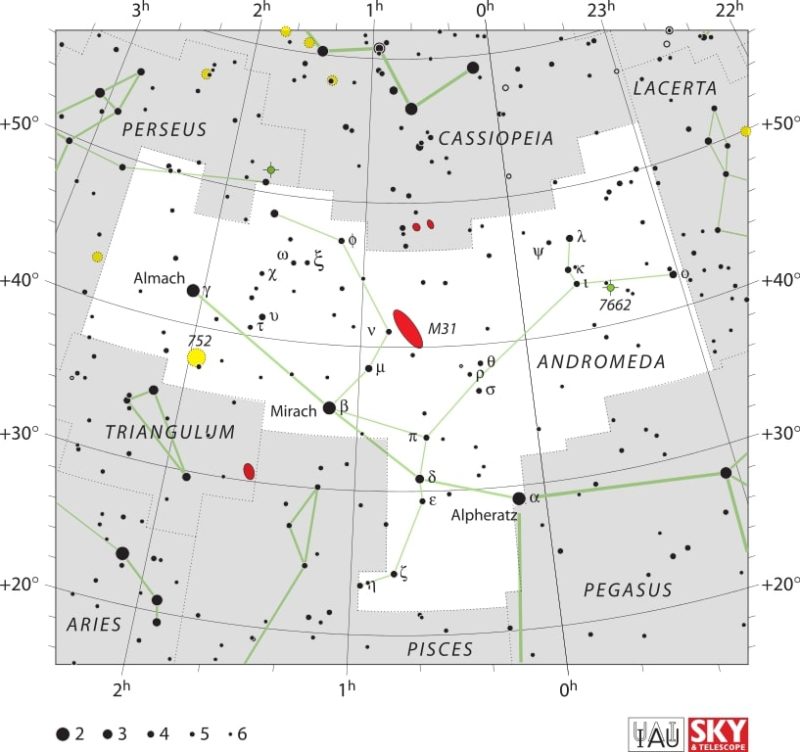
October 3: The Sculptor Galaxy (NGC 253) at its highest point in the sky
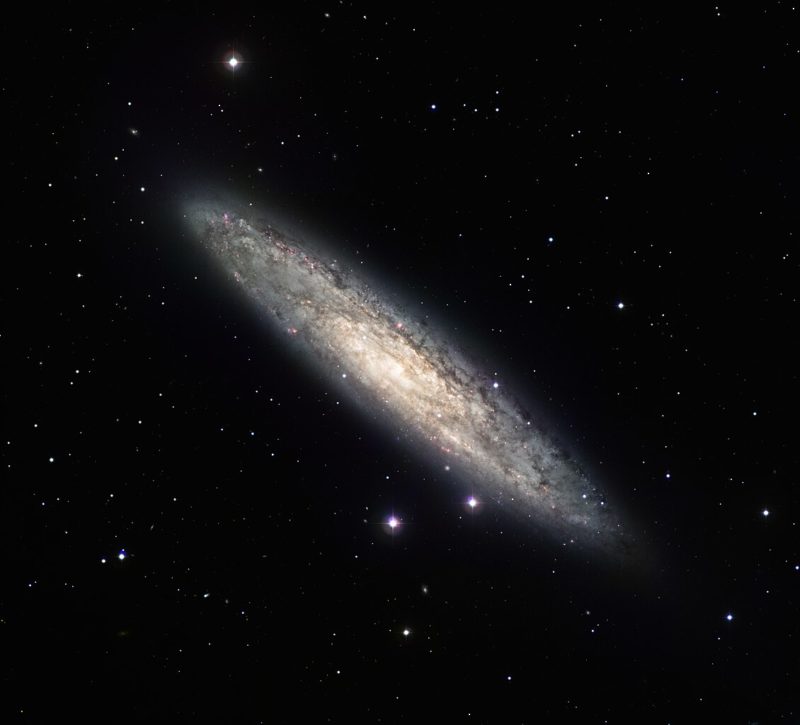
The Sculptor Galaxy (also known as NGC 253, Silver Coin Galaxy, Silver Dollar Galaxy, or Caldwell 65) in the constellation of Sculptor is an intermediate spiral galaxy. At apparent magnitude 7.1, this galaxy is visible with a small telescope. The Moon will be 12 days old waxing gibbous at about 90%.
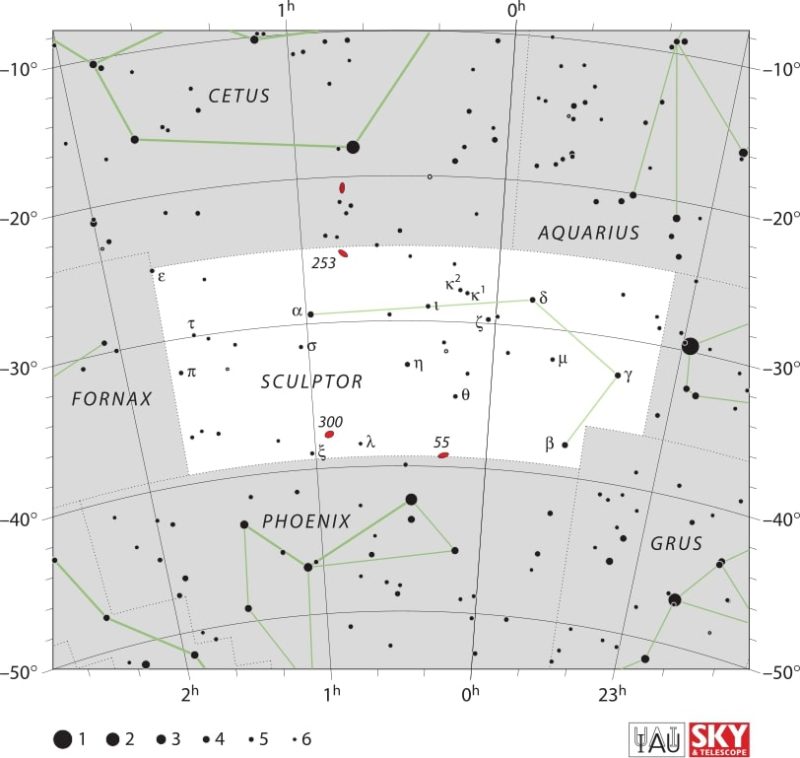
October 4: The Small Magellanic Cloud at its highest point in the sky
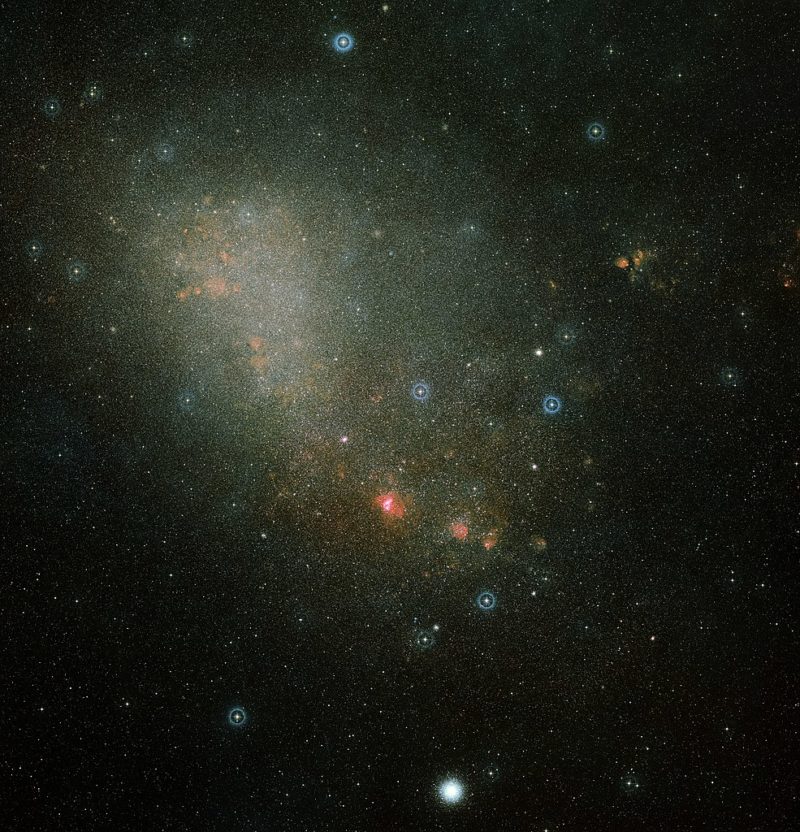
The Small Magellanic Cloud (SMC) is a satellite galaxy of the Milky Way. The galaxy will reach its highest point in the sky at around midnight local time.
With an apparent magnitude of 2.7, the SMC can be seen with the naked eye, but for better results I would recommend at least a pair of standard binoculars. Look in the constellation of Tucana in the Southern Hemisphere. The Moon will be 13 days old waxing gibbous at about 95%.
The Small Magellanic Cloud is located 204,000 light-years from us. It has been named after Ferdinand Magellan who observed it during his voyage of circumnavigation of the world in 1519.
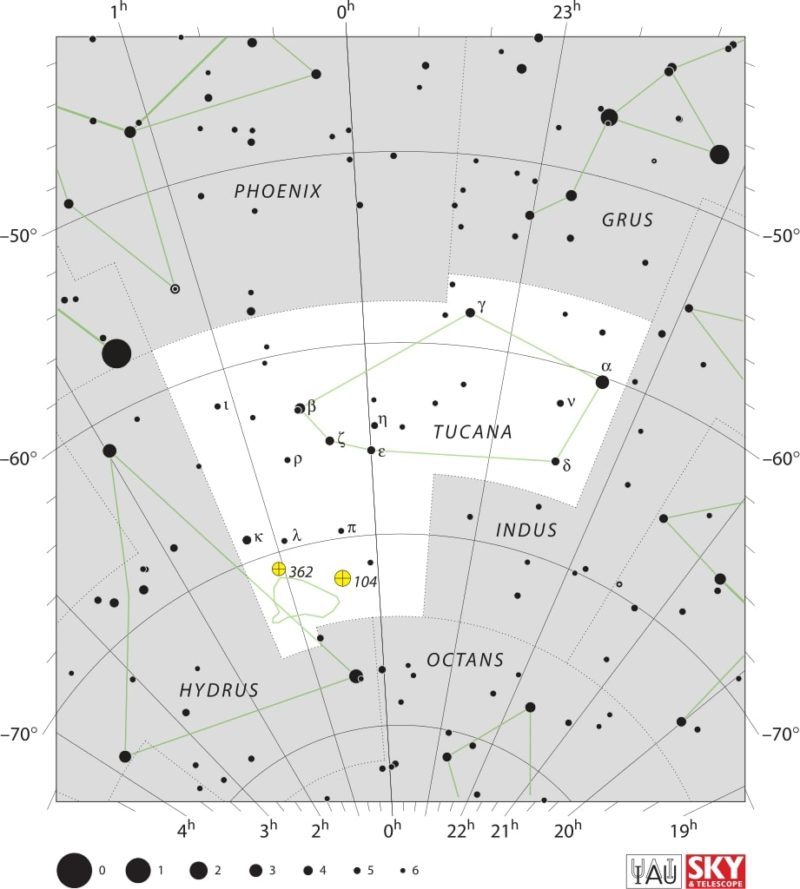
October 6: October Camelopardalid meteor shower peak
The October Camelopardalids are a short and variable meteor shower that will peak on October 6 and will only last two days (October 5 and 6). The meteors will radiate from the constellation of Camelopardalis at the speed of 46 km/s on average. The Moon will be 15 days old waxing gibbous at about 99%.
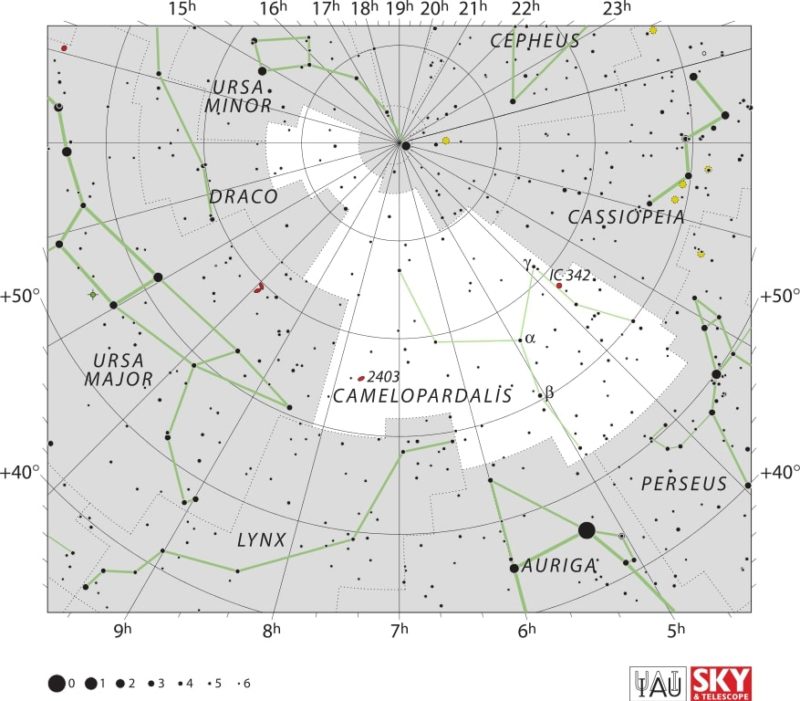
October 6: Conjunction of the Moon and Saturn
The Moon and Saturn will reach conjunction passing within 3°47′ of each other while sharing the same right ascension.
Around the same time, the two bodies will also make a close approach (appulse) reaching 3°19′ from each other, but not sharing the same right ascension.
The Moon will be at apparent magnitude -12.7 in the constellation of Pisces and Saturn at magnitude 0.6 in the neighbouring constellation of Aquarius.
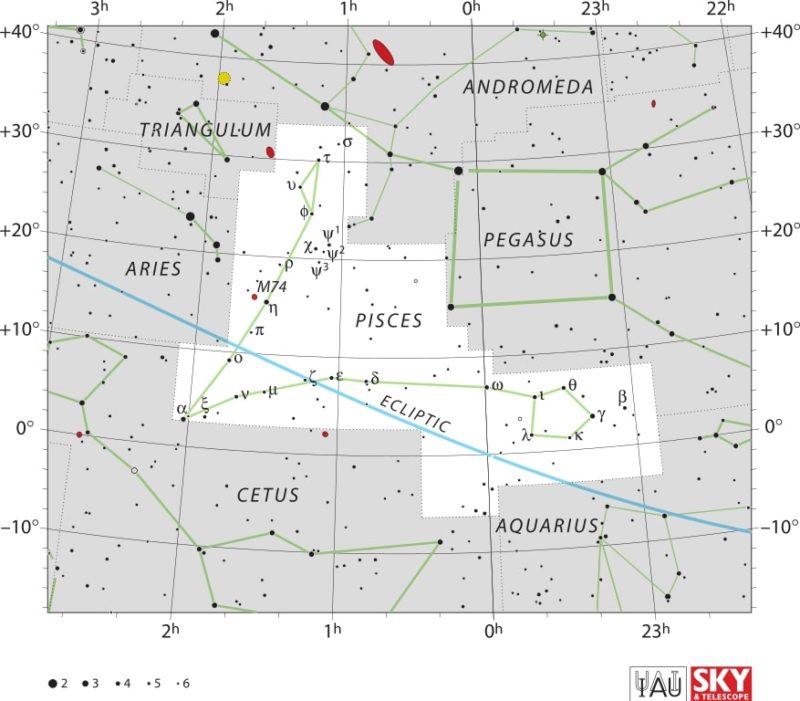
October 8: Comet C/2025 K1 (ATLAS) at perihelion
The comet C/2025 K1 (ATLAS) will reach perihelion, meaning it will reach the closest point in its orbit to the Sun at a distance of 0.33 AU.
It will have an apparent magnitude of 10.6 according to the BAA Comet Section. It will be located in the constellation of Corvus.
Keep in mind that the comet will be only 8° from the Sun, so don’t point a telescope this close to the Sun as you risk eye injury or even permanent blindness.
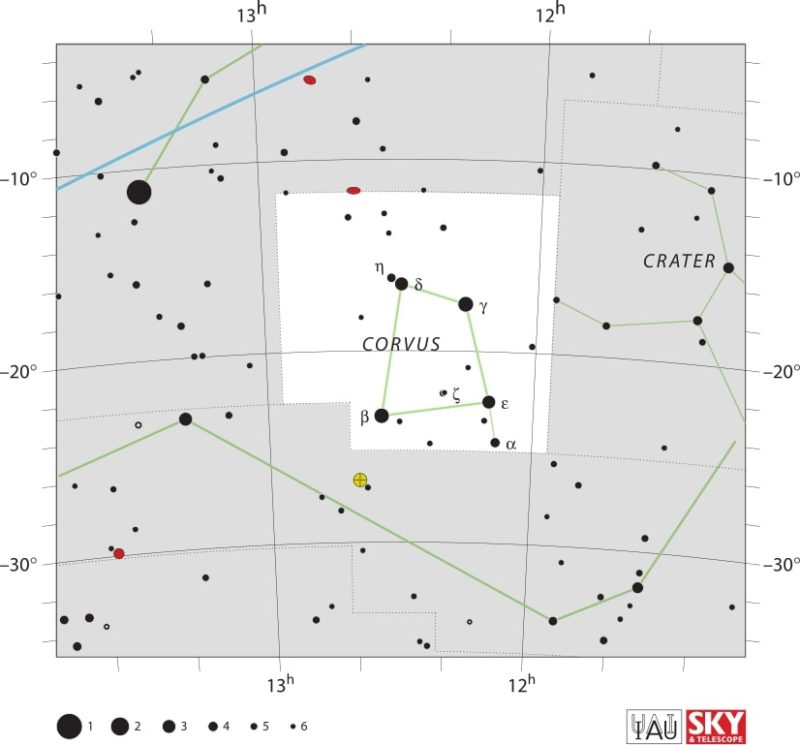
October 8: Draconid meteor shower peak
The Draconids are another short and variable meteor shower that will peak on October 8. Some meteors may also be spotted between October 6 and October 10. They will radiate from the constellation of Draco at the speed of 20 km/s on average. The Moon will be 17 days old waning gibbous at about 93%.
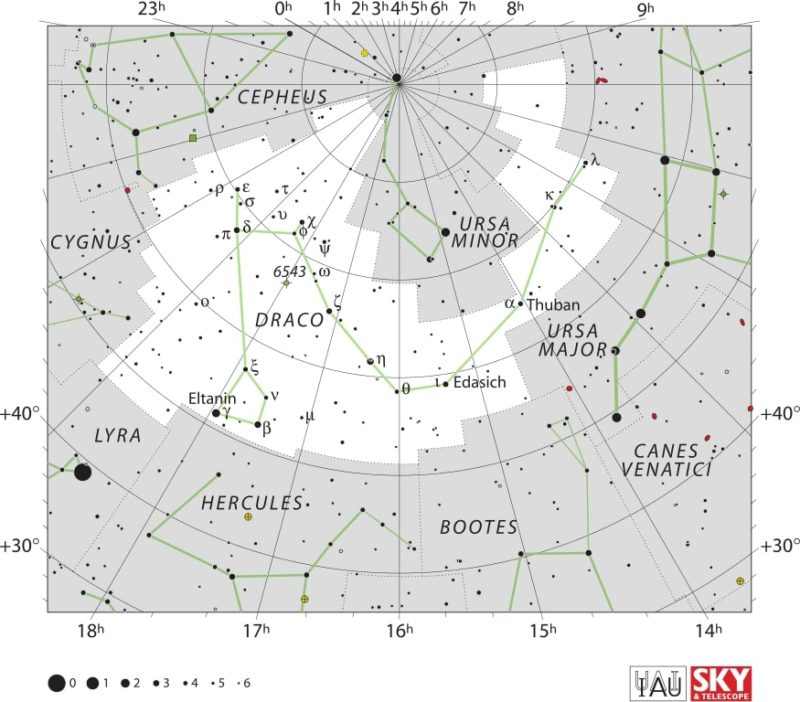
October 10: Close approach of the Moon and Pleiades
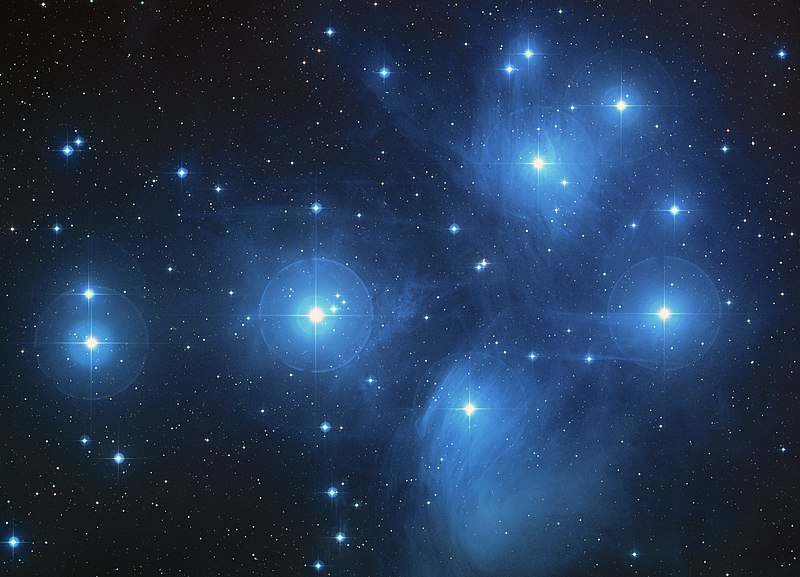
The Moon and the Pleiades star cluster (M45) will make a close approach or appulse, by passing within 54.7 arcminutes of each other. This will happen in the constellation of Taurus.
You can observe this astronomical event with the naked eye because the Moon will be at apparent magnitude -12.6 and M45 at 1.3. The Moon will be 19 days old, meaning it will be waning gibbous at 82%.
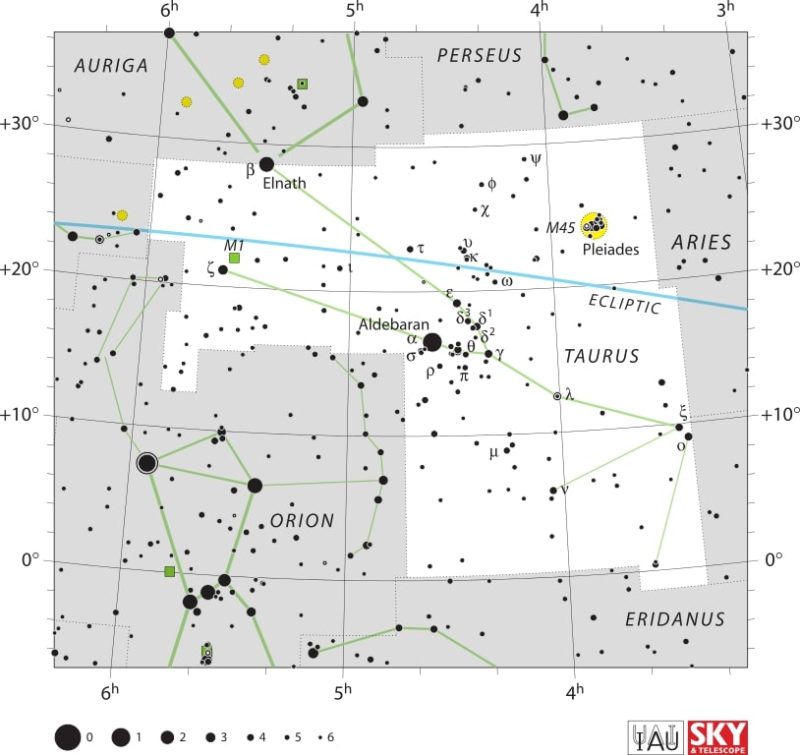
October 10: Southern Taurid meteor shower peak
The Southern Taurids will peak on October 10 with a zenithal hourly rate of 5. The Moon will be 19 days old waning gibbous at 80%.
Some meteors may also be spotted between September 10 and November 20. They will radiate from the constellation of Cetus at the speed of 27 km/s on average. (Constellation map already displayed above, when discussing dwarf planet Ceres at opposition on October 2.)
October 11: δ-Aurigid meteor shower peak
The Delta Aurigids are a small meteor shower with an average of 2 meteors per hour (ZHR) during the peak if conditions are ideal. The Moon will be 20 days old waning gibbous at 70%.
Some meteors may also be spotted between October 10 and 18. They will radiate from the constellation of Auriga at the speed of 64 km/s on average.
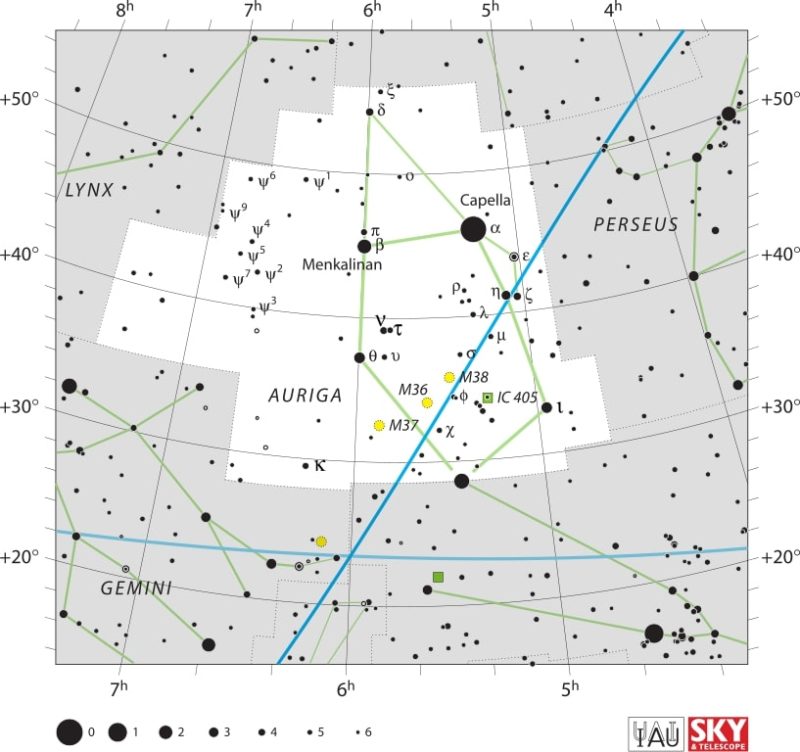
October 13: Conjunction of the Moon and Jupiter
The Moon and Jupiter will be at conjunction by sharing the same right ascension and passing within 4°16′ of each other.
Around the same time, the two bodies will also make a close approach (appulse) reaching 4°10′ from each other, but not sharing the same right ascension.
The two celestial bodies will meet in the constellation of Gemini with the Moon at apparent magnitude of -11.9 and Jupiter at -2.2. The Moon will be 22 days old waning crescent at 42%.
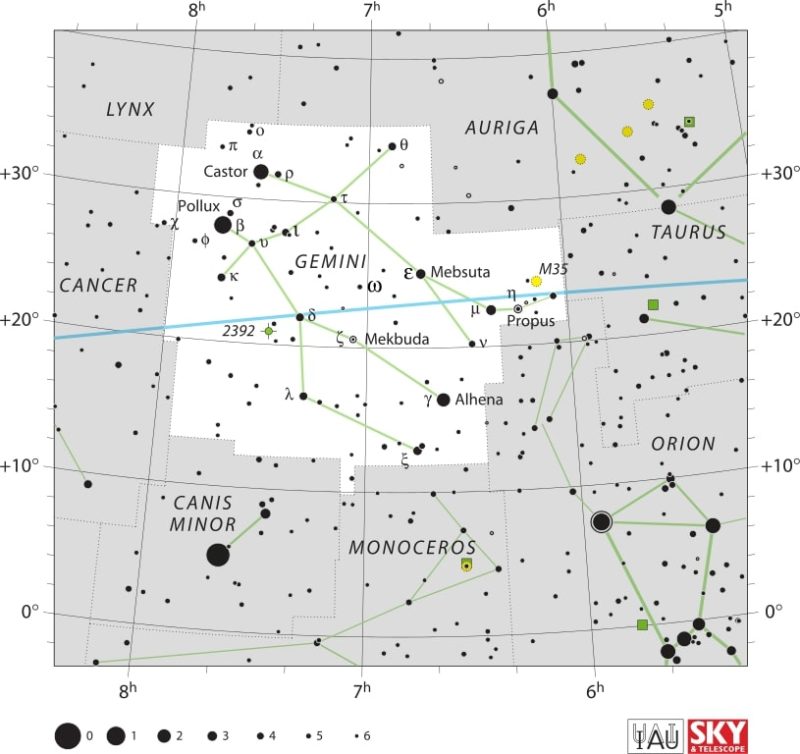
October 15: The Triangulum Galaxy at its highest point in the sky
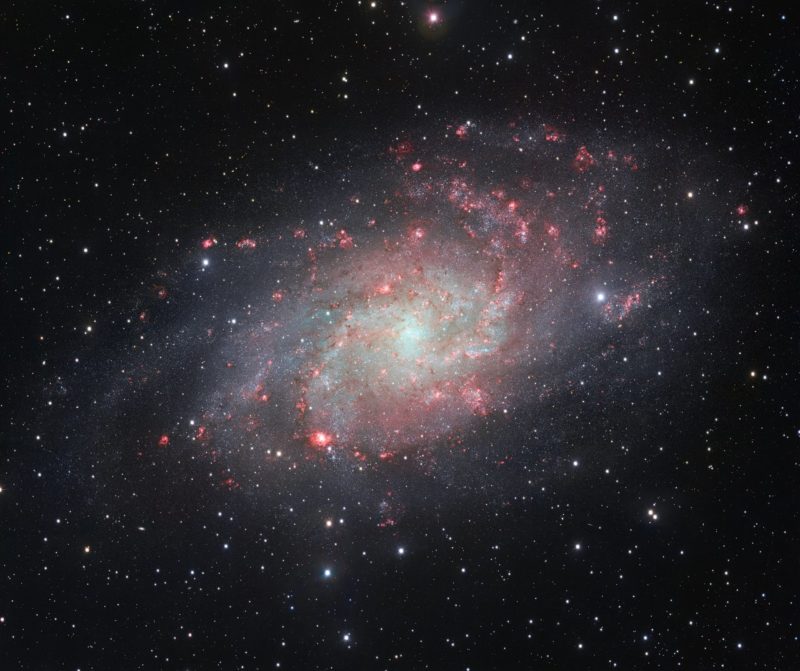
The Triangulum Galaxy (Messier 33, M33, or NGC 598) will reach its highest point in the sky at around midnight local time. It can be found in the Triangulum constellation, not far from its neighbor the Andromeda Galaxy.
It will reach apparent magnitude 5.8 and will be extremely difficult to spot with the naked eye, so a pair of binoculars or a small telescope would be recommended. The Moon will be 24 days old waning crescent at 22%.
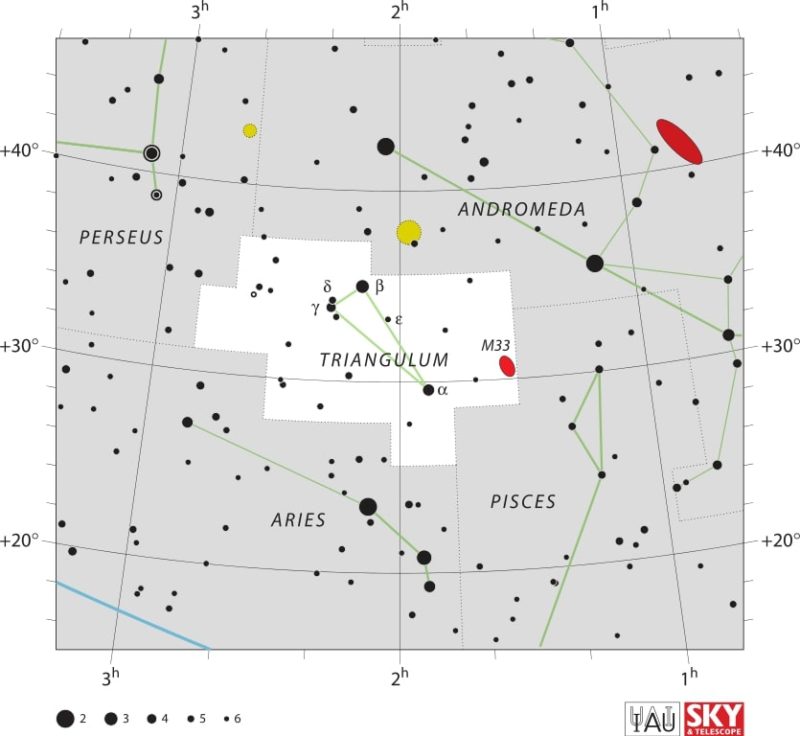
October 18: Dwarf planet Eris at opposition
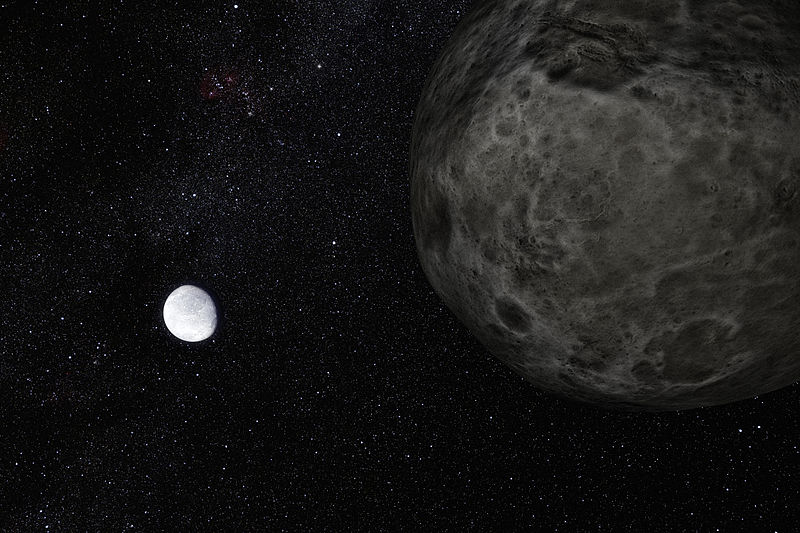
ESO/L. Calçada and Nick Risinger. License: CC BY 4.0.
The dwarf planet 136199 Eris will reach a point opposite to the Sun in the sky, known as an opposition. This will happen around midnight local time, regardless of where in the world you are.
With an apparent magnitude of 18.6, you will most definitely need a powerful telescope. If you have access to one, look in the constellation of Cetus. (Constellation map already displayed above, when discussing dwarf planet Ceres at opposition on October 2.) The Moon will be 27 days old waning crescent at 6% and so won’t be interfering much with stargazing this middle of October 2025.
At about the same time, Eris will also make its closest approach to the Earth (perigee) at a distance of 94.57 AU, making this the best time to observe the dwarf planet.
October 18: ε-Geminid meteor shower peak
The Epsilon Geminids are a small meteor shower with only 3 meteors on average during the peak if conditions are perfect. Although the peak is on October 18, some meteors could also be spotted between October 14 and 27.
The meteors will appear to radiate from the constellation of Gemini at the fast average speed of 70 km/s. (Constellation map already displayed above, when discussing the conjunction of the Moon and Jupiter on October 13.) They originate from debris of the comet C/1964 N1 (Ikeya).
October 19: Conjunction of the Moon and Venus
The Moon and Venus will be at conjunction by sharing the same right ascension and passing within 3°41′ of each other.
Look for the two bodies in the constellation of Virgo. The Moon will be a 28 days old, very thin waning crescent at 1%. Despite this, the Moon will still be at apparent magnitude of -8.5, while Venus will be at magnitude -3.9.
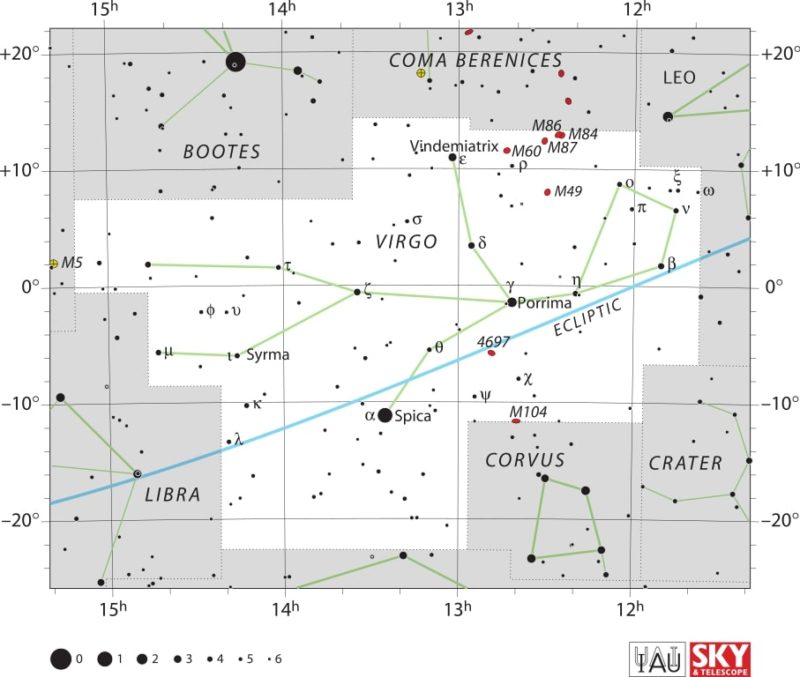
October 21: Conjunction of Mercury and Mars
Mercury and Mars will pass within 2°07′ of each other while sharing the same right ascension, in what is called a conjunction.
Both planets will be visible in the constellation of Libra, with the Mercury at apparent magnitude -0.2, and Mars at 1.5. The Moon will be at the new moon phase.
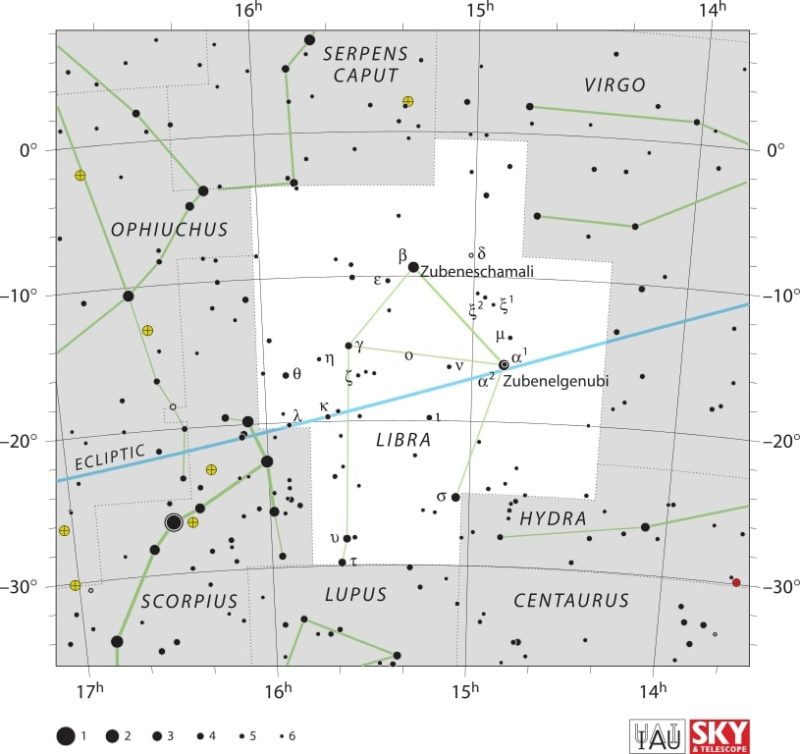
October 22: Orionid meteor shower peak
The Orionids are a medium sized meteor shower with an average of 15 meteors during the peak if conditions are optimal. Some meteors can also be seen between October 2 and November 7.
The meteors will appear to radiate from the constellation of Orion at the fast speed of 66 km/s on average. They originate from debris left behind by the famous Halley’s Comet. The Moon will be 1 day old waxing crescent at 2%.
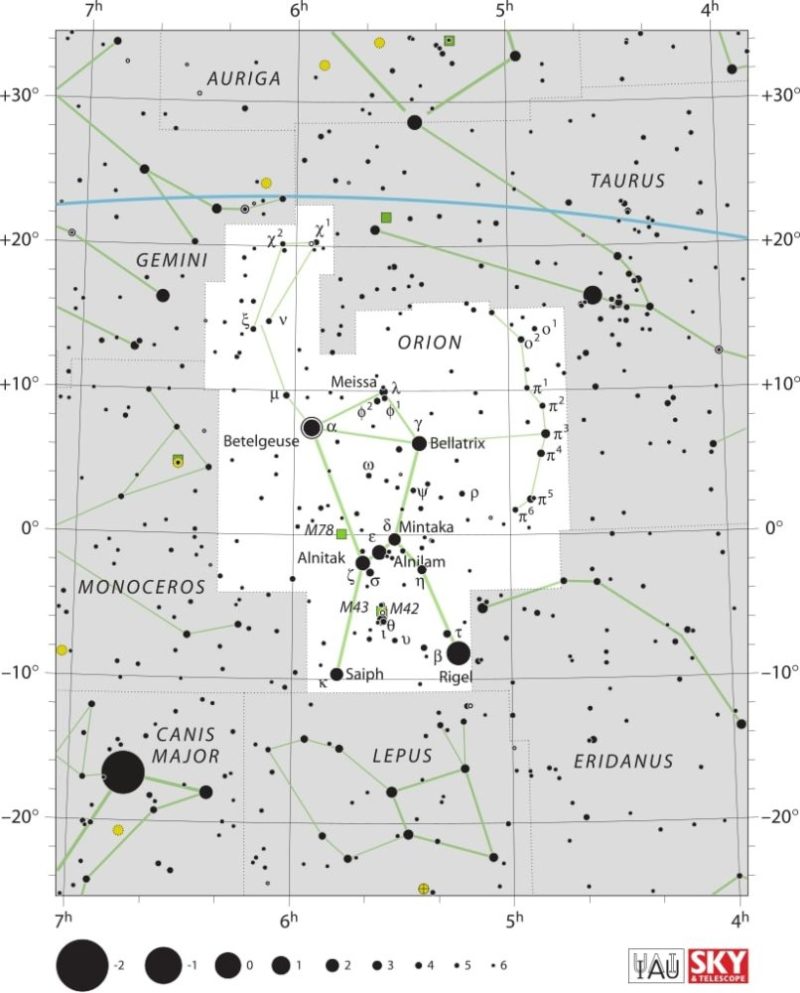
October 23: Conjunction of the Moon and Mars
The Moon and Mars will be at conjunction by sharing the same right ascension and passing within 4°30′ of each other.
Look for the two bodies in the constellation of Libra. The Moon will be at apparent magnitude of -9.0, while Mars will be at magnitude 1.5. The Moon will be a 2 days old waxing crescent at 5%. (Constellation map already displayed above, when discussing the conjunction of Mercury and Mars on October 19.)
Mercury will also be nearby, waiting for it’s own conjunction with the Moon.
October 23: Conjunction of the Moon and Mercury
The Moon and Mercury will be at conjunction by sharing the same right ascension and passing within 2°15′ of each other.
The two celestial bodies will meet in the constellation of Libra. (Constellation map already displayed above, when discussing the conjunction of Mercury and Mars on October 19.) The Moon will be at apparent magnitude -9.1 for and Mercury at -0.2.
October 24: Leonis Minorid meteor shower peak
The Leonis Minorids are the final meteor shower to peak this month of October. It is a small one with only 2 meteors per hour on average during the peak, with ideal viewing conditions. The Moon will be a 3 days old waxing crescent at 10%.
Some meteors can also be seen between October 19 and 27, radiating from the constellation of Leo Minor at the high average speed of 62 km/s. The originate from debris of the comet C/1739 K1.
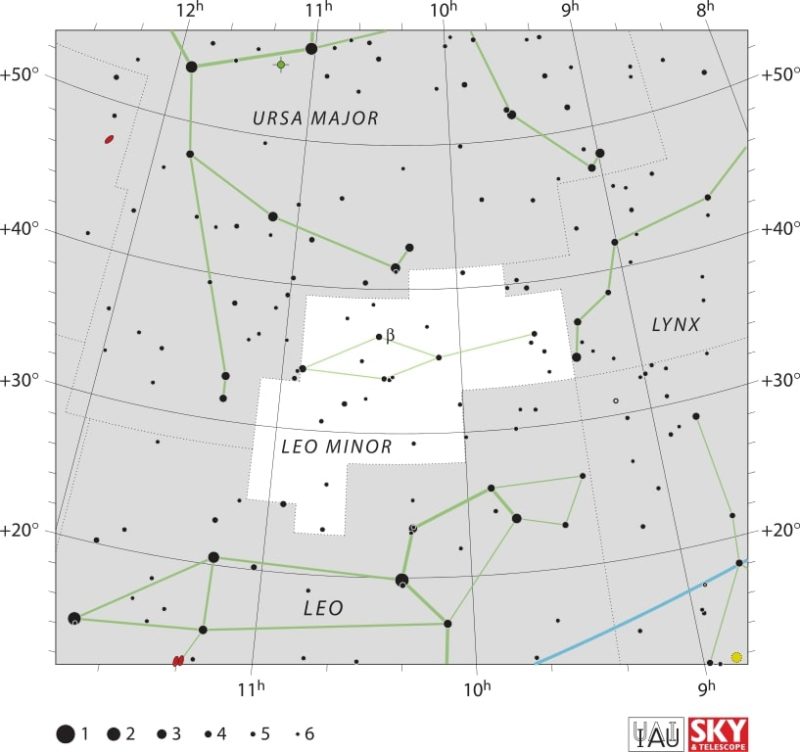
October 29: Comet 3I/ATLAS at perihelion
The interstellar comet 3I/ATLAS (see featured image at the begining) will reach perihelion, meaning it will reach the closest point in its orbit to the Sun at a distance of 1.36 AU.
It will have an apparent magnitude of 14.9 according to the BAA Comet Section. It will be located in the constellation of Virgo. (Constellation map already displayed above, when discussing the conjunction of the Moon and Venus on October 19.)
Keep in mind that the comet will be only 12° from the Sun, so don’t point a telescope this close to the Sun as you run the danger of suffering eye damage or perhaps permanent blindness.
October 29: Mercury at greatest eastern elongation
Mercury will be at its highest point above the horizon in the morning sky, making it the best time to view the planet. Look for it low in the western sky just before sunrise. It will be at apparent magnitude 0.4 in the constellation of Cancer. The Moon will be 8 days old waxing gibbous at 56%.
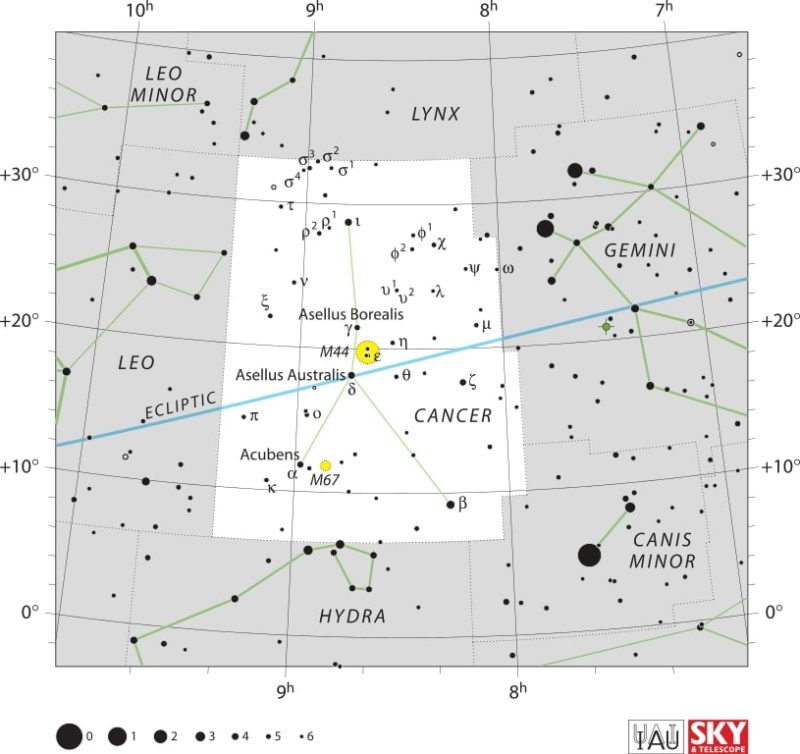
Positions of the Planets in October 2025
- Mercury: The closest planet to the Sun can be seen at dawn and dusk travelling across the constellation of Virgo and then Libra. This planet, being the closest to the Sun, will appear to move quickly in the night sky and its position will change in the following weeks.
- Venus: The sister planet can be seen travelling across the constellation of Leo and then Virgo later in the month. Just like Mercury, Venus can only be seen at dawn and dusk.
- Mars: The red planet can be seen in the constellation of Virgo and the Libra.
- Jupiter: The gas giant is visible in the constellation of Gemini. Jupiter can easily be spotted with the naked eye, even in highly illuminated cities.
- Saturn: The ringed giant can be seen with the naked eye in the constellation of Aquarius.
- Uranus: The ice giant can be seen in the constellation of Taurus with the use of a telescope.
- Neptune: The blue giant requires a telescope pointed in the constellation of Pisces in order to be seen.
Positions of Dwarf Planets and Large Asteroids in October 2025
- Ceres: The asteroid belt’s lone dwarf planet can be seen in the constellation of Cetus with the help of a telescope.
- Vesta: This large asteroid can be seen in the constellation of Ophiuchus with a telescope.
- Pallas: The asteroid can be observed with a telescope in the constellation of Aquila.
- Hygiea: The fourth largest asteroid can be found with a telescope in the constellation of Gemini.
- Pluto: This distant dwarf planet can be found in the constellation of Capricornus with the help of a large telescope.
Major astronomical events next month – November 2025
- November 11: Jupiter enters retrograde motion
- November 11: Asteroid 471 Papagena at opposition
- November 12: Northern Taurids meteor shower peak
- November 17: Leonids meteor shower peak
- November 21: Uranus at opposition
- November 21: α-Monocerotids meteor shower peak
- November 22: Comet 210P/Christensen at perihelion
- November 28: Saturn ends retrograde motion
- November 28: November Orionids meteor shower peak
- November 30: Mars at apogee
- November 30: Andromedids meteor shower peak
Conclusion
October 2025 promises an exciting lineup for stargazing, from dazzling meteor showers to planetary conjunctions and distant galaxies at their peak. Whether you’re observing with the naked eye, binoculars, or a telescope, this month offers countless opportunities to deepen your appreciation of the night sky. For anyone passionate about astronomy, these events make stargazing in October 2025 a truly unforgettable experience.
To ensure you don’t miss out on any celestial happenings, sign up for our newsletter to receive stargazing calendars and more updates. Keep your telescopes ready and clear your calendar for these cosmic highlights!
Sources:
- Planetary ephemerides produced by NASA’s Jet Propulsion Laboratory (JPL)
- International Meteor Organization
See also:
- Previous month’s calendar: Stargazing Calendar for September 2025
- Next month’s calendar: Stargazing Calendar for November 2025
Would you like to receive similar articles by email?




